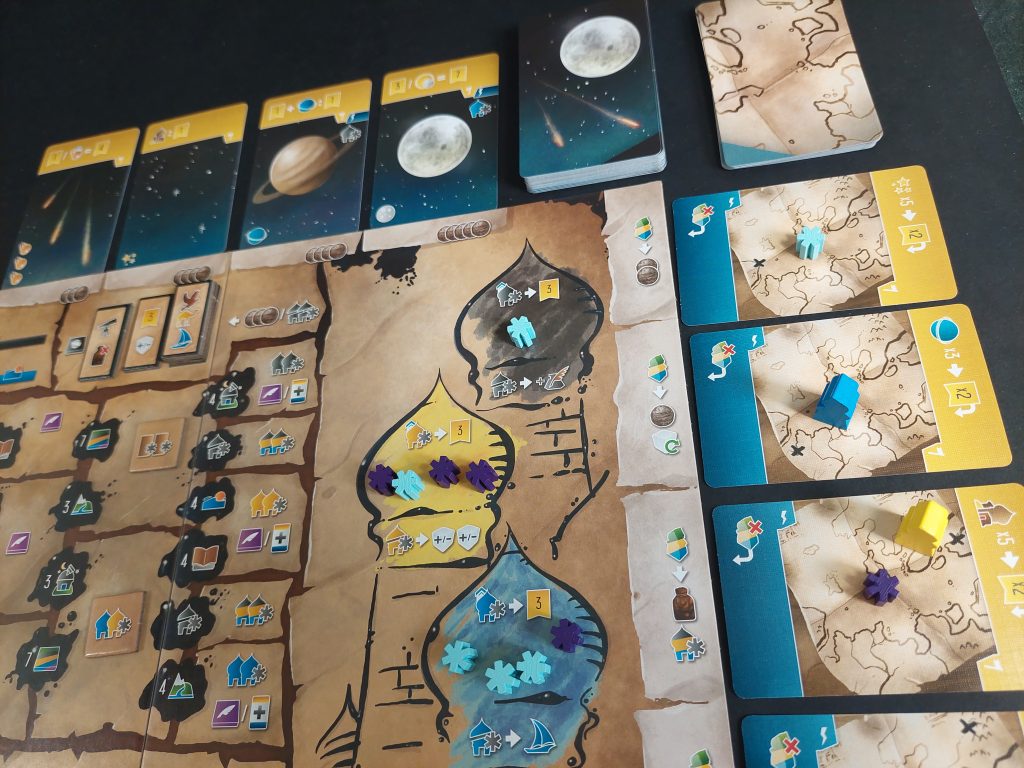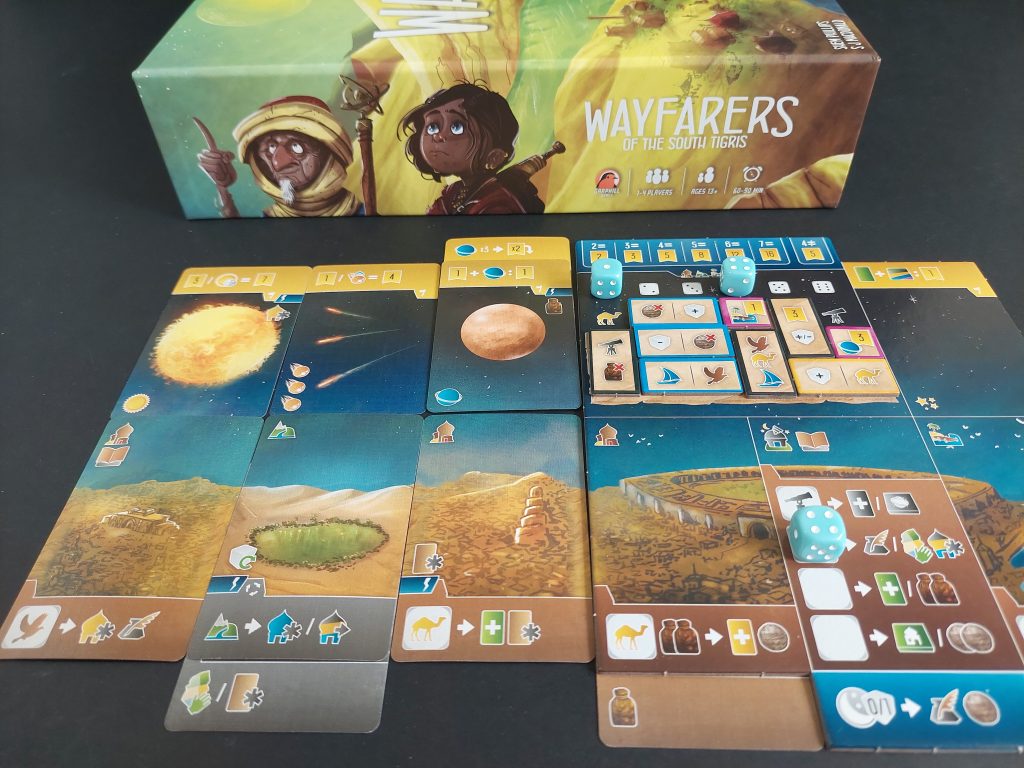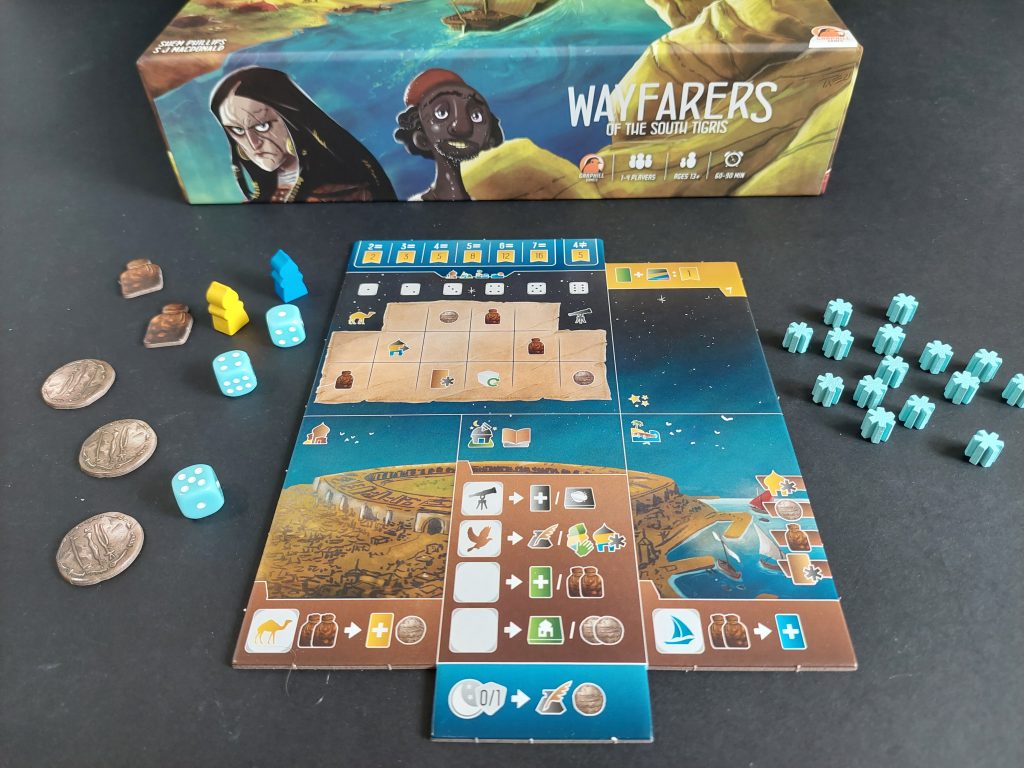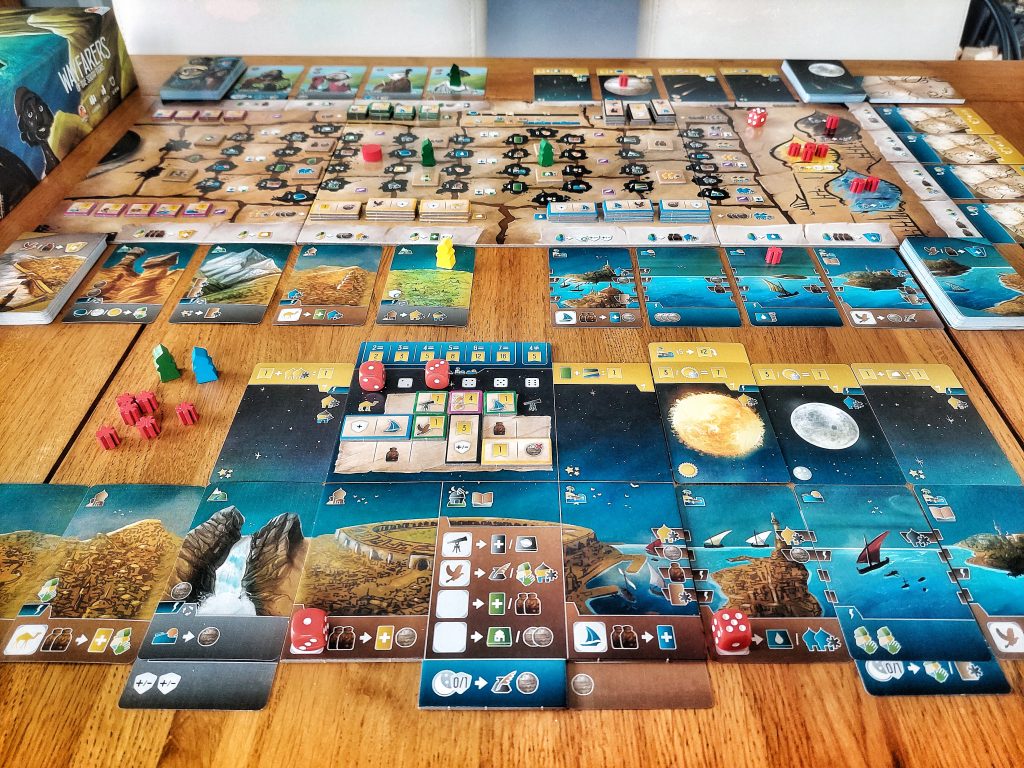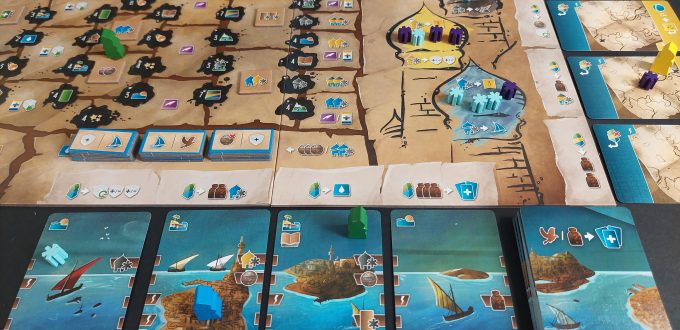Tom’s sailing away to the South Tigris in his review of Garphill Games’ latest euro-style tableau building game!
Publisher: Garphill Games
Designer: Shem Phillips and SJ MacDonald
Artist: Mihajlo Dimitrievski
Release date: 2022
Player Count: 1-4 Players
Time: 120+ minutes
Score 9/10
It’s the dawn of a new era. Whenever Garphill Games announce a trilogy, we’ve come to expect nothing short of greatness. First came The North Sea (Shipwrights, Explorers and Raiders). This let us get our inner Viking on – albeit in a Euro-style, not-too-combat-y fashion. Next, The West Kingdom saw a new setting and the ante upped by a considerable amount. Architects, Paladins and Viscounts were far heavier hitters with regards to complexity. Their popularity saw them become something of a board game triumvirate. All three sit within the Top 150 ranks on boardgamegeek.com (if you pay attention to such things).
So when Shem Phillips and SJ MacDonald dropped a new trio of games on the horizon, excitement levels hit new decibels. A new location – the South Tigris – and a new box colour! Artist Mihajlo ‘The Mico’ Dimitrievski is along for the ride, too. His art style is somewhat synonymous with Garphill trilogies. So can Wayfarers of the South Tigris live up to the somewhat unfair levels of hype?
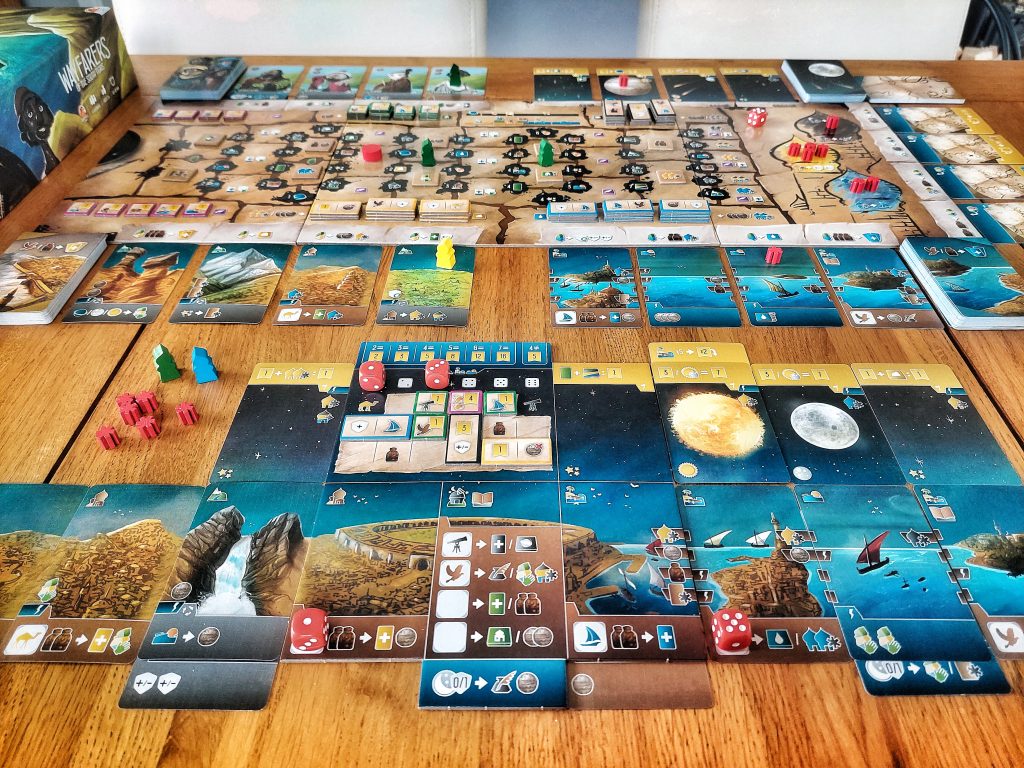
What’s It All About?
Wayfarers of the South Tigris is a Euro-style tableau-building game. There’s a plethora of other mechanisms going on here, dovetailing with one another in an organic, slaloming style. There’s worker placement, and dice allocation/manipulation. There’s set collection, area majority, and track movement. Some features reminded me of Garphill tricks of old, but there are some new ingredients here, too.
Players aim to earn the most points by constructing a tableau of cards. The setting is Baghdad circa 820 AD, during the Abbasid Caliphate – the Golden Age of Islam. You start the game in Baghdad. Your goal? Map the surrounding regions. Will you head eastwards, out to sea? Westwards, to scout the land? And all the while, you’ll also want to look up, too! There’s a big old sky full of stars up above, which means as cartographers you’ll have your hands full…
You start with an asymmetrical player board, which acts as your own version of Baghdad. Over the course of the game, you’ll add cards to the immediate left and right of this. Think of it like creating a panorama that’s part-set collection, part-engine building. Players begin with three standard D6 dice, a yellow and blue worker, some starting resources and Influence tokens. You’ll use these items to buy cards throughout the game.
The main board, meanwhile, is a modular affair. It comes as three separate boards that sit together, rather than one static board you fold out. They’re all double sided too, meaning there’s seven different layouts for starters! Then, there’s 10 spots here for you to place Journal Tiles in a random order. They’re rewards you’ll earn when you reach them. Therefore, the odds of you playing with the same layout twice is slim-to-none. You’ll have to adapt your strategy every time you play, which is a popular trait of many modern Euros.
This main board is like you ‘journaling’ your progress. It’s passageway through knowledge, which you’ll deliver to the House of Wisdom! Your marker starts at the far left, and at various stages of the game, you can progress, point-to-point, along it. You’ll earn goodies every time you advance. But to travel along this, you need to have the right knowledge required to do so! You’ll need to have explored various landmarks (by acquiring cards with particular symbols). When one player reaches the end of this Journal board, it triggers the end of the game. Time to add up the value of your tableau, AKA calculator o’clock!
So to some extent, you can treat Wayfarers like a race. But do you want to rush to the end-game, if you don’t have the most valuable tableau?

How Do You Want To Explore This?
There’s five different card decks in Wayfarers – yes, five. Let’s not beat around the bush; you’re spinning many plates, here. There’s land cards, and water cards (which sit to the respective left and right of your tableau). You’ll want these for end-game set collection rewards, as well as some being requirements to move along the Journal. One particularly cool feature about sea cards is that they have focal points on the left and right side of them. Meaning, when you sit two next to each other, if they line up, you get extra immediate bonuses on the card as soon as you buy it. Not essential, but this provides an extra layer of thinking for next-level strategists!
There’s Townsfolk cards, which tuck underneath water or land cards (adding passive benefits when you trigger said water/land card). Build that engine, baby! There’s space cards, which sit above the water and land cards (they’re the sky above them). These have individual end-game scoring promises on them. And then there’s Inspiration cards, which tuck under the space cards. (Thus multiplying the value of the space card’s score, if you complete the Inspiration requirement as well.) Phew! That’s a lot to try and collect!
You always have four cards from each deck face-up around the main board. (20 cards.) At an initial glance at the three boards sat together, you might think Wayfarers is quite small (24x65cm). Don’t let this fool you! Once you add all the cards around it though, it leaps up to 42x73cm, which is almost double the surface area. When you add into this enough space for players to build wide tableaus of their own? You need a table of a certain size to play this.
All 20 of these cards are available for you to buy into your tableau. Plus, 16 of these 20 cards have an extra purpose: they’re worker placement spots. This can feel a daunting for first-time players, since there’s a lot to absorb, and a hefty amount of iconography. There is at least a solid breakdown of all icons on the reverse of the rulebook. I would have preferred some kind of player aid. But, like many Euros, once you’ve played the game the iconography becomes familiar.
On your turn, it all boils down to action selection. You can either place a worker (on a vacant card), taking the action stated on the main board adjacent to said card). Instead, you can place one of your dice (onto one of your own cards, or your starter player board). This triggers the action stated on the card/board. Or you can rest, which you tend to do once you’re out of workers and dice left to place. Resting is one of the main ways you can move one space along the main board – providing you’ve met the requirement to progress. Then you get your dice back; you reroll them in preparation for your next turn.

Temporary Workers: Not Yours To Keep!
The workers are neat, for a couple of reasons. First, they come in three colours – like in Raiders of the North Sea. Akin to Raiders, you can only place certain colour workers in certain locations. Once players progress along the main board, the first to reach thresholds unlock a green worker for themselves. These are wild and can sit anywhere, making them super-useful. (Plus, a further incentive to race along the Journal, itself.)
And the best twist about the workers? They’re not yours to keep (a similar mechanism to the one used in Lewis & Clark). Once you place a worker on a card, you take the parallel action on the board, in accordance to where the card sits. If a player later on purchases that card, they also claim the worker that’s on it! This is a fantastic addition, because it makes you consider whether to buy that card over another. It comes with a free worker! Once purchased, the cards slide down one notch and new one gets added. This is also cool because if any workers remain on those cards, they’re now blocking different actions (or others have freed up). Or, in the case of the space cards, they become cheaper to purchase.
The worker actions around the board are simplistic enough to digest. The iconography is the worker silhouette/colour requirement (plus resources, if there’s an extra cost). Then there’s an arrow, pointing at what you get. They’re usually handy actions if you’re caught a little short of resources to afford a bigger and better move. They range though, from: buying certain card types, gaining resources, paying for upgrade tiles, bonus movements along the main journal board, or mitigating dice pips.
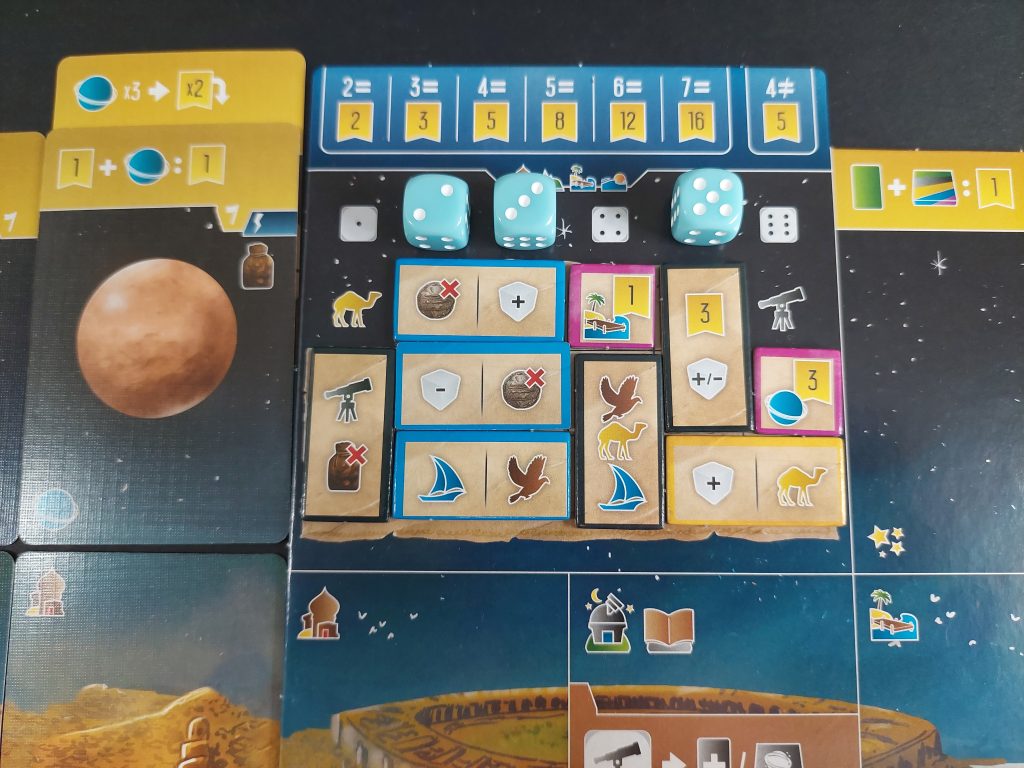
Dice Management: Wayfarers’ Beating Heart
Talking of dice: they play an even larger role compared to the workers. A significant chunk of Wayfarers is dice management, and it is one heck of a puzzle you’re trying to solve. On your individual player board, each player has a 3×6 grid: you Caravan. Each column corresponds to your dice, 1-6. When it comes to placing dice, to begin with you have a default land and sea location either side of Baghdad on your player board. Some have symbols on them, like a camel (for land) and a boat (for sea), for example. To place a die on this location, it needs to be of a pip value that provides said symbol within your Caravan.
At the start of the game, for example, a 1 provides a camel symbol. Thus, if you rolled a 1, you can place that die on a camel within your tableau to gain that action. (The starter action on your board is ‘place a die, plus two provisions, to take any land card plus one coin’.) Thus, a huge part of Wayfarers is about improving your Caravan by purchasing upgrade tiles. You overlay them on top of this grid, earning rewards underneath when you do so. This improves the flexibility of your die rolls. Considering every players’ Caravan is asymmetrical, each player builds a different Caravan game-to-game.
The upgrade tiles are a wonderful addition, because they provide plenty of variety. Will you try to flesh out your Caravan with icons galore, so no matter what you roll you can place your dice where you want? What about adding in some tiles that let you add/subtract die pips to mitigate bad rolls? Instead, will you fill your Caravan with discounts, so buying cards is cheaper in the long run? Or is filling it up with upgrades that are worth points the way forward?
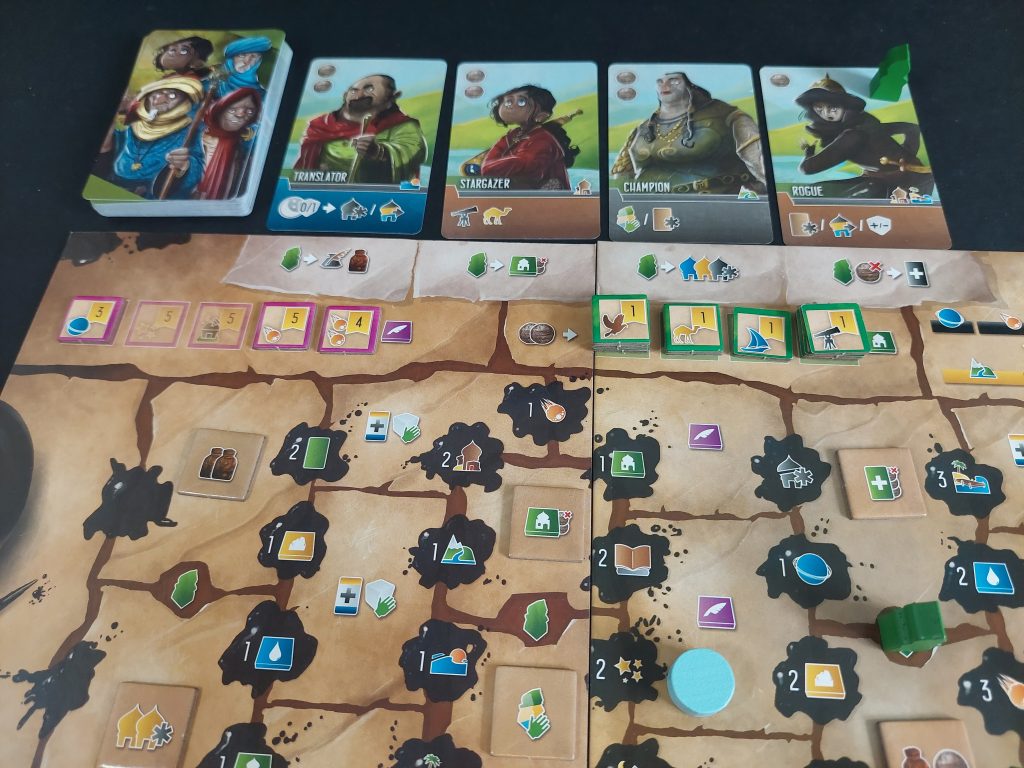
If It Ain’t Broke…
And I haven’t even talked about the Townsfolk cards yet! You tuck these under certain land/sea cards that you’ve already acquired. The Townsfolk card then acts as a passive, ongoing benefit every time you trigger that particular land/sea card. Some even provide you with extra bonuses every time you rest. These can become a vital shot in the arm at timely intervals.
The Townsfolk tucking-under mechanism reminds me of the tool cards in the Architects expansion, Age of Artisans. Meanwhile, the Inspiration cards feel lifted straight out of Raiders of Scythia. (They’re like Eagles doubling the warrior’s ability below.) Not that I’m complaining. I love both of those games!
So too must Shem and SJ MacDonald, because these feel like a case of ‘if it ain’t broke…’ approach. Borrowing mechanisms your older, tried-and-tested games? It’s a trick the likes of Uwe Rosenberg and Alex Pfister have used time and time again. There’s more than enough different things whirring away here, though. Wayfarers feels like a different beast in comparison to older Garphill titles, though. The dice Caravan is a whole new ball game.
Art And Components
You know what you get with The Mico when it comes to art. There’s a delightful range of caricatures among the Townsfolk deck, with a solid ratio of mixed ethnicities and gender. All five types of cards are 100% iconography. The game is language independent throughout.
However, I didn’t think much of the rulebook. It wasn’t the easiest to digest, and felt a bit back-to-front in places. First it explained all the cards, the Journal and more. This was before it even told you what the three basic actions were you take on your turn (workers/dice/resting). It felt mentally exhausting to digest the rules in an organic manner when reading it. Now, I appreciate that Wayfarers is a complex beast of a Euro, with lots of little rules that require explanation. But rulebooks can create such a barrier of entry to many folks, and I felt a little dizzy reading this one.
The box is larger than the smaller size we’ve become accustomed to for the likes of the other Garphill trilogies. Wayfarers is the standard ‘Ticket To Ride’-size box. I’m glad that fitting all the components in isn’t a major squeeze like it is for the likes of Raiders of Scythia! In fact, Wayfarers even comes with a yellow (nice touch, in tone with this trilogy’s colour) custom insert. There are additional slots for tokens than those needed. Has it already got room with expansion material on the way?
You’ve got to assume an expansion will rear its head at some point. That’s the Garphill way; they’ve done it for many of their other titles (via Kickstarter). Right now, I don’t feel like I need an expansion for Wayfarers though… There’s a lot to concentrate on as it is!
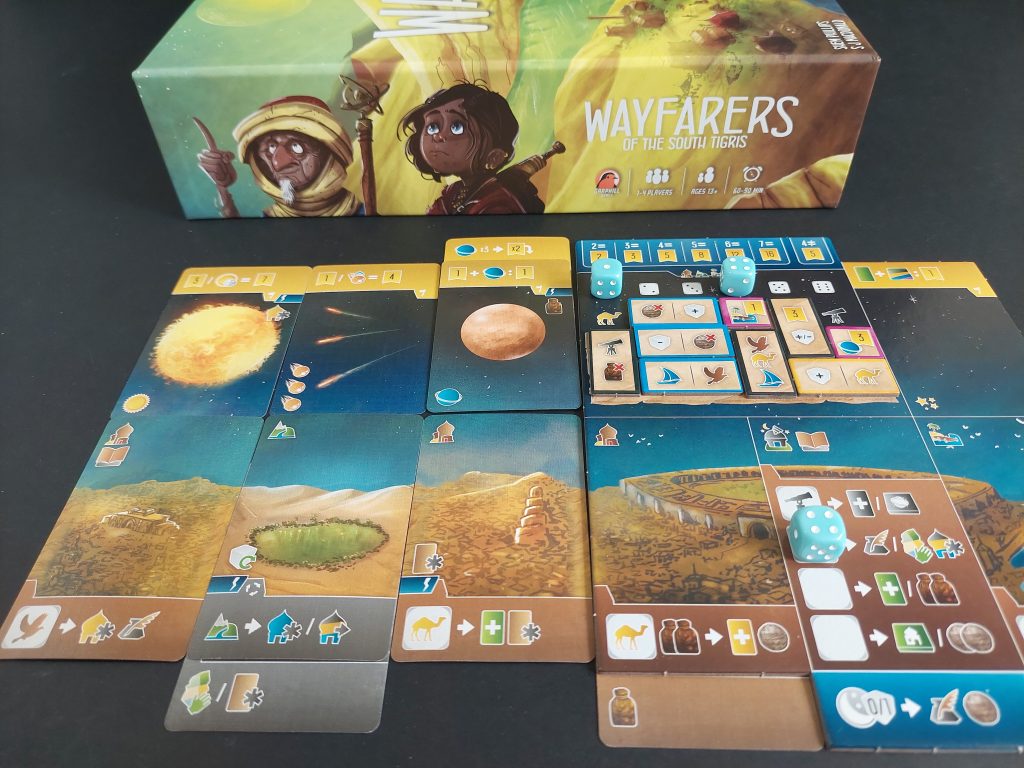
Plan Versus React
Player interaction is somewhat distant with regards to direct attacking opponents. But you can – and will – block opponents to the cards’ worker placement spots. You can also place Influence tokens on public cards. This doesn’t block per se, but it does make it more expensive to visit them. (By the end though, you want to get Influence tokens into the three minarets on the Journal, for extra are majority bonuses.)
With players buying cards and spaces freeing up (or becoming blocked), Wayfarers is not a game in which you can plan ahead. You have to react on your turn. This can cause dreaded analysis paralysis. A pre-planned move can judder to a halt in the blink of an eye, causing impromptu rethinks.
This adds a considerable amount of time into gameplay. (Which, I should say, I didn’t mind… But I had an entire afternoon put aside to play the game, so time was not an issue.) But I appreciate others might wince at the thought of a three-plus hour game. The box says 60-90 minutes, but this is not the truth. I always say that the times on the box are for people who already know how to play. Not for when even one person at the table is learning it for the first time. But even when playing this as a 2-player game, for two experienced gamers, it still took 200+ minutes!
Talking of which: the box says 2-4 players. No. Just because it says it can play four players, doesn’t mean you should. This is a two-player game. And even at two players, it isn’t a short experience! The downtime between turns could kill momentum with four. Plus the rate at which the game state changes by the time it’s your turn again? You won’t get the satisfaction you crave out of this if you want a long-term strategy if you play with three or four players. Also, it’s not unusual for the width of your tableau to reach 12 or more cards wide. As a result: will you have a table big enough for four players to build sprawling tableaus?
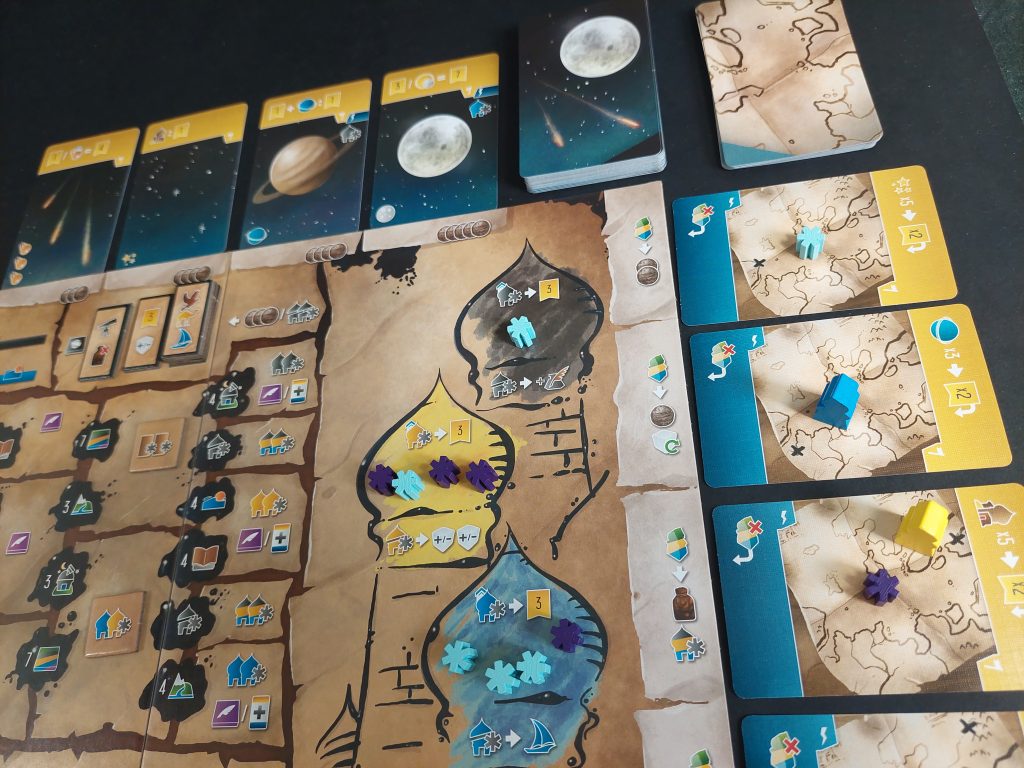
Don’t Be An Ostrich
There’s plenty of different ways to score points in Wayfarers, but space cards is an angle you cannot ignore. They provide end-game goals that you can start shooting for the moment you buy the card. (Especially so if you can tuck Inspiration cards underneath them.) You can earn a decent amount of points by focusing on the set collection aspect of the land/sea cards, though. But ignore the space cards at your peril!
You can only buy a space card if you have a spare land/sea card with room above it in the first place. This is clever because it forces you to focus on multiple tasks, and not pound the same singular drum time and time again. Your eyes dart all over the place, looking for your next move! I also loved the fact that in many ways, Wayfarers is about stretching your actions out for as long as you can. It’s like Everdell. You want this action to provide you with the means to afford your next action, and so and so forth. Certain actions let you pick up an already-placed die of yours and reroll it. This means you can spend it again on a later turn without needing to rest to get it back. It also means you might be able to activate that card’s dice placement spot again.
It’s inevitable that you’ll need to rest at some point. Besides, it’s the main way you’ll progress along the journal. And you’ll want to do that, to try and unlock extra workers, extra dice, and the chance to gain free Inspiration cards. One thing I learned the hard way is you can’t afford to stay static when resting. You have to ensure you can progress whenever you rest, or you can fall behind for both engine-building and end-game benefits. This means checking ahead along the journal and planning what kind of cards you need to buy. To be specific, they demand you have a certain quota of icons among your tableau (or within your Caravan). Usually, regardless of which path you take across the Journal, there’s always two paths to pick. Regardless: keep an eye on it!
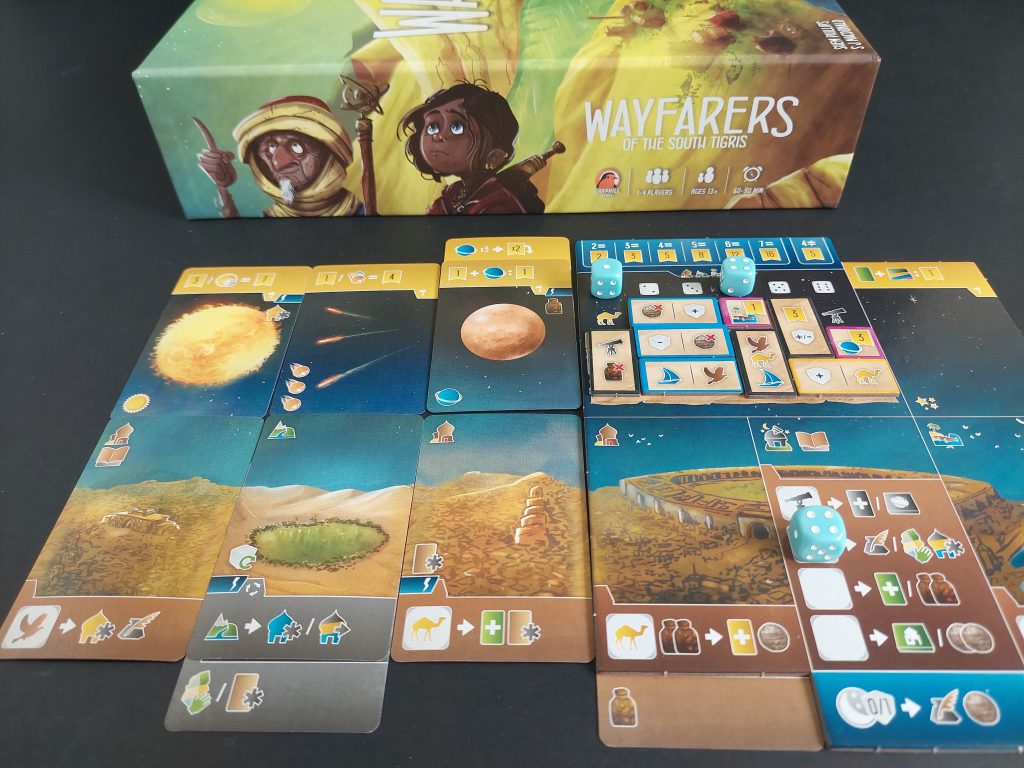
Final Thoughts On… Wayfarers Of The South Tigris
Overall, Wayfarers of the South Tigris is a significant step up from the North Sea trilogy, and also the likes of Architects of the West Kingdom. At the time of writing, I haven’t played Paladins or Viscounts, so I can’t compare it to those two. But Wayfarers sits (at the time of press) at 3.73/5 in terms of complexity according to boardgamegeek.com.
Building a tableau is satisfying, especially when your previous turn finances your next one. (The Everdell Effect!) Working out how to create a rock-solid Caravan so you can get the most out of your dice is a clever conundrum. When you see the fruits of your labour paying off, you get that feel-good fist-clenching vibe. Everyone wants to experience that “Eureka!” moment when playing games, right? The workers not being yours on a permanent basis is a wicked twist. It makes you value them a lot more compared to other worker placement games! And with a modular set-up every time? Wayfarers has a bucket-load of mileage. Garphill Games have done it again!
It’s unfortunate that I won’t play this at three or four players due to game length and table footprint. But that’s okay: there’s plenty of other Garphill titles that scratch that four-player itch. This is a fantastic two-player puzzle (and it plays solo, too) and one I’ll happily play time and time again. Providing I have a spare three hours, that is…

